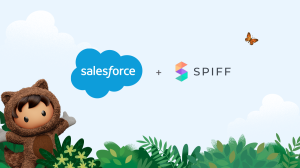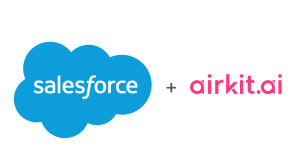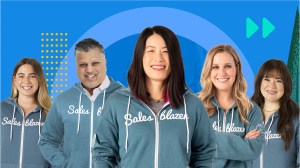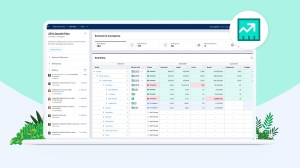There was no pandemic playbook for businesses before this year, and because of that, sales leaders were flying blind and sales reps were doing the best they could under challenging circumstances. Published this morning, the fourth edition of our State of Sales research report looks at how sales teams worldwide are adapting to this new normal, and data shows that pandemic changes have hit outside sales teams hardest. To better understand how these insights translate to real-life experiences, we got on a (virtual) call with two sales leaders from our very own sales teams.
Jen Lee, regional vice president of enterprise sales, leads a sales team that is focused on the consumer goods industry, and works with companies that are already our customers, as well as what we call green prospects — companies that have no prior experience or relationship with Salesforce — so her team is used to being on the road and in in-person meetings where they can gain the trust of their future customers.
Lynn Knaak, vice president of SMB Central, on the other hand, leads an inside sales team based out of Dallas, specifically selling to small and medium businesses, and is used to interacting with customers through phone calls. Her team was in the office Monday through Friday with just a handful of face-to-face customer meetings per month.
Q. Let’s go back to those initial days in March when companies and cities were shutting down left and right. What was that like for you personally, and your teams? What were the first steps your teams took to shift to work from home so suddenly?
Jen: I had a few new people join my team recently, so not only did I have to quickly pivot on how we got to know each other, but how to work with one another from afar. I was traveling every single day of the month. My team was used to face to face meetings, doing live lunch-and-learns and social and volunteer events, and all of that stopped overnight.
We started daily standups, where every morning and afternoon we’d have a cup of coffee or a drink so we could talk about the human elements of what was going on, because no one really knew what was happening and it was a scary time.
We also spent a lot of time curating a list of customers that might have been affected — we heard about plants shutting down, production issues, or companies doing layoffs or furloughs. We took that list to see what kind of businesses we could support.
I admit we did put pause on the business for a bit, until we understood what was actually transpiring for ourselves personally in our home lives. And then we wanted to figure out quickly what was taking place with our customers, and how we can help them accelerate and go digital. First and foremost we had to get comfortable from a human standpoint, and then we could worry about whether or not we could do business together.
Lynn: I was used to working in the office a few days a week, and working from home a few days a week, but without my kids around. So, with an eight, four, and two year old, they are very much at the ages they want to be near me, and those early days of full time working from home were hectic. I was battling the feeling of not doing anything well — not being a good mom, or a good employee, or a good leader for my team — and dealing with endless amounts of guilt. But then you kind of settle into it. I have a few employees with young kids, so I reached out to them first to make sure they were okay, and I also have younger employees that are sitting alone in their tiny apartments that I was worried about. It probably took two or three months to settle into it.
The data confirms we transitioned to working from home pretty easily — we were a team that was already adept at selling from our laptops and over email. Once we realized this wasn’t just a temporary thing and that it would be this way for awhile, we had another pivot where we were able to rethink, “what does my day look like when I don’t have to shower and commute to an office? How can I still hold myself accountable?”
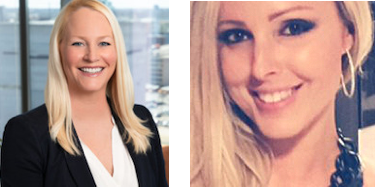
Q. There’s no denying that, while we’ve probably gotten used to working from home, we’re still in the middle of a stressful time for a lot of people. How has your team adapted to building trust with customers during this challenging time?
Jen: We’ve done virtual wine tastings, pilates sessions, cooking lessons — for example, this winery I’ve been working with is led by this really innovative woman, and she’s had a digital-first mentality even before COVID, so we talk about those trends while she’s hosting us. It is a lot of networking but also just trying to do some fun bonding experiences. We’re hosting a wellness summit right now with a day of Peloton rides and yoga classes that our customers and their spouses come to, because after all, they’re sitting at the same kitchen table. We’re also doing things for kids, like having a pumpkin painting party and a magic show, all virtual.
It’s so cliche but it’s true, that people want to do business with people they like and trust, so a lot of time right now is spent cultivating those relationships. We’re just trying to be inclusive and get people to feel like there’s some sense of normalcy in the world, and create some really unique experiences for people to get to know one another.
Lynn: Salesforce is a performance-driven culture, so we had to take a step back, take a breath, and remember our mantra is to always lead with empathy. We had the 1 Million Conversations initiative as a business unit and the goal was to touch as many customers as possible — ask them how they’re doing, find out where they are in their journey, how is their business impacted, how are their families impacted? And to really just listen.
That was about three or four months, and I think it worked well, as our revenue would suggest. I think coming at it from that point of, “we’re going through it too, I completely understand,” helped us gain a lot of credibility and trust with our customers, to let them know we’re there alongside them.
Q. Did going remote drive your team or org to use any new technology or tools for communication or collaboration?
Jen: We have a team chat that we are always on. We communicate a lot more with the technology we already had, like Chatter, and use Quip for everything. We use Canva to create some infographics that our customers have then used as a value proposition about why they should invest with us. We’re also getting back to the basics with a lot of phone calls again.
Lynn: During quarantine, I needed to hire 10 or 11 new account executives, and the entire onboarding and bootcamp experience was remote, so we felt they were missing out on the real Salesforce onboarding experience. We found this service called Kudoboard where the team can leave notes, GIFs, images or soundbites to help the new members feel welcomed. We even used Cameo where you can hire celebrities to deliver virtual welcome messages which was fun and a little more personal too.
We definitely saw an increased usage of chats and video calls, and we try to do everything we possibly would in person over a Google Hangout. We also have several more break out chat groups, like one for the entire SMB selling org to ask those “swivel chair” questions that you would normally ask the people you’re sitting around if you were in the office.
Q. What did your customer meetings or calls usually look like prior to the pandemic?
Jen: I was all over the United States in all sorts of headquarters, with usually five to 10 people from Salesforce and about the same on the client side. You’d really get to know one another, go out to dinner together after, but that’s not happening anymore. But what I have noticed is that I spent so much time on the road, I didn’t have the time to comb through a company’s 10-K, or look through their website for areas of opportunity like I can now. I also find I have more time to guide my team because I’ve become a lot more in control of my calendar. It’s given us a chance to slow down and ask, how can we really help partner with companies in their time of need right now?
Lynn: The conversations that we have to have with stakeholders or an executive team in order to get a deal across the finish line — those haven’t changed much, except that they’re now virtual instead of face to face. But when you think about our go-to-market strategy, the framework in which we hold these meetings is a new norm.
So, given where we are now as a city, state, or society, how is your business impacted? How do you need to serve your customers differently? What’s your technology stack look like and are you setting yourself up to thrive in this new norm? How are you able to stay connected in a unique way with your customers? These questions have always been there and are built into our product features, but there’s a new approach of “how are you remaining relevant in this new world?”
Q. Now that we’re six months into remote work, what are some of the biggest challenges and benefits your team has seen?
Jen: It’s great to be at a company like Salesforce where we have so much like freedom to be creative and come up with our own solutions for how we can connect with people to drive value.
There are a lot of challenges, from people isolated in tiny apartments to homeschooling their kids while working, and it’s reminded me it’s so important to be flexible with my team, because I want them to be at their best, and being at their best may no longer be the 8am-5pm working hours that it used to. But, everyone is going through this unifying experience and it feels like it’s going to be a huge catalyst for change and innovation, which has kept me hopeful.
Lynn: This is making all of us a lot more human when we’re talking to our customers and we’ve got the dog barking, or the mail person ringing the doorbell, or your kids are screaming in the background.
As for challenges, I have a young team and they’re used to being in a high-energy, fast paced office environment, so you want to make sure they’re not too isolated. But I think we’ve come out the other end, and when you don’t have as many distractions with those swivel chair questions, you’re able to get really focused and be more productive in a six hour time frame than a normal eight hour workday in the office. I also love that I’m having more well-being conversations — I’ve had a lot more “but how are you really doing?” conversations in the last six months, and I like that.
Q. Do you think you’ll take any learnings from pandemic selling into the future when some sense of normality resumes?
Jen: This has allowed me to reset my schedule. As a people leader, I am now able to stop and think about the skill sets that my team member needs and instead of joining a call because they don’t possess that skill and do it for them, I can take the time to teach them. I’ve been running a lot of enablement programs around qualification methodologies and negotiation, and I’m using my time to better upskill my team so that they can be the best possible partner to their clients.
Lynn: From a tactical level, it’s helped us qualify our time better and be a little more deliberate with our time. Do I need to go on this trip that I have to expense and be out of the office for three or four days to meet two customers? On the other side of the token, I think we’re humanizing B2B selling. After having conversations with people at their dining room table, you’re humanizing the entire sales process.
+++
Visit our newsroom post and download the full State of Sales report for a deeper analysis of our findings.




